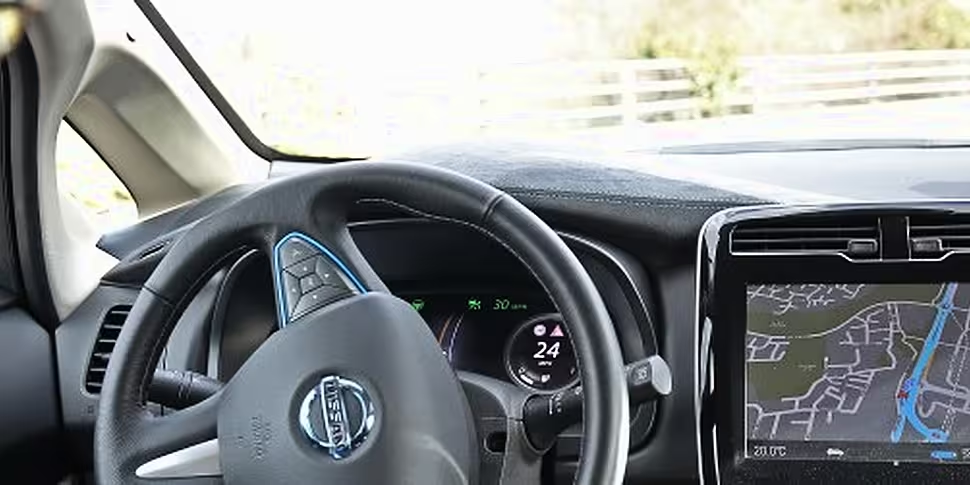Driverless or automated vehicles have long been one of those uniquely potent science-fiction ideas.
Such an idea, after all, follows a wonderfully effective and evocative rule of much futuristic world-building - take one recognisable element of modern society, and change something simple to make it seem fresh and alien (but also within the realms of believability). No surprise, then, then the concept of a car that drives itself has captured the imagination of many authors and filmmakers.
Whether it’s the iconic digitised voice of Knight Rider’s KITT or Tom Cruise’s death-defying leaps between automated vehicles in 2002’s Minority Report, there’s no doubt driverless cars entered the popular consciousness long before the technology was feasible. You can see the enduring appeal in the continued popularity of the Transformers franchise, while only recently a motorway of ‘drone trucks’ made for one memorable setting in the ‘near future’ superhero film Logan.
But science-fiction creators in the near future may have to return to the more distant dream of flying cars (ahem), as automated vehicles are very much becoming a reality. Although you may have to wait a little while yet to see them on Irish roads...
Where we’re at
Even though the technology that will control automated vehicles is still very much in its infancy, there has been a notable level of progress in recent years.
Although traditional car manufacturers such as Nissan, BMW and Toyota have been experimenting in the area, relative newcomers have also gotten in on the act - including Google, Uber and Tesla. In many ways, it represents two industries converging - the motor industry and the tech sphere.
It’s important to note that there is a spectrum of autonomous vehicles - ranging from ones with some degree of automated assistance to ones that are truly ‘driverless’. This is perhaps best explained by the Society of Automotive Engineers' (SAE) six-tier classification guide.
Level 0 refers to vehicles with no automation. Going a step up to level 1, it is mainly the driver in control, but there is also a “driver assistance system of either steering or acceleration/deceleration using information about the driving environment”.
In SAE’s system, the level of automation increases in incremental steps all the way up to level 5 - full automation where the driving system is able to carry out “all aspects of the dynamic driving task”. The levels before involve various balances between automation and human input.
While we are likely to see many intermediary steps along the way, many companies are aiming towards full automation. Google’s Waymo, for example, say they’re “committed to developing fully self-driving cars because we believe that this is safer and better for the millions of people who cannot drive”.
The company boasts that their cars have driven “over two million miles on public roads across four US cities”, and are aiming to have drivers - or, indeed, non-drivers (self-driving vehicles could well blur the lines between driver and passenger) - to test vehicles for tasks such as running errands and commuting to work.
Electric car manufacturer Tesla’s Autopilot is perhaps the most prominent commercially available example of automated technology to date. The company boasts that “all Tesla vehicles produced in our factory [...] have the hardware needed for full self-driving capability at a safety level substantially greater than that of a human driver”.
Currently, some ‘driver assist’ features are enabled in Tesla cars - including ‘Autosteer’ functionality - but the company hopes to roll out more features in the coming months, “subject to regulatory approval”.
Indeed, all automated technology companies will likely face themselves having to overcome various regulatory and legal roadblocks as they seek to get more vehicles on the road - although 'wireless updates' mean new software features can be installed in compatible vehicles relatively seamlessly as soon as they're good to go.
Autopilot for HW2 rolling out to all HW2 cars today. Please be cautious. Some cars will require adjustment of camera pitch angle by service.
— Elon Musk (@elonmusk) January 21, 2017
Tests and trials of automated technology have become more complex and ambitious in recent years. Ford, for example, have tested some of their prototype vehicles in snowy conditions:
Why the rush towards automated technology?
There is no doubt that the emergence of ‘driverless’ cars will have significant social & economic consequences - both positive and potentially negative.
From the perspective of some major companies, full automation surely cannot come soon enough. Uber, for example, has made huge investments in developing driverless technologies. It doesn’t take many leaps to see why: cutting human drivers out of the equation will lead to lower costs for customers, but a massive increase in profit for the company when expensive and unreliable “human resources” are drastically reduced. As cynical as it sounds, people remain the biggest expense for companies like Uber.
Raffi Krikorian, Uber’s engineering director, told Bloomberg last year: “The goal is to wean us off of having drivers in the car, so we don’t want the public talking to our safety drivers.”
The company’s CEO Travis Kalanick, however, has offered a somewhat conflicting viewpoint that doesn’t completely remove drivers from the equation. He argues that their fleet will increase massively, but tens of thousands of drivers will still be needed to ‘watch over’ cars and drive to areas fully automated vehicles won’t be able to reach (tough terrain, for example, or areas with poor Internet connectivity).
Kalanick suggests that while the percentage of drivers will go down, the actual number of drivers won’t. He observed: “I don't think the number of human drivers will go down anytime soon. In fact, I think in an autonomous world, it goes up. In absolute figures. Of course, in percentage it's down.”
Even if you accept Kalanick’s conclusion, there is no question driving as we know it will be fundamentally changed. Tesla founder Elon Musk has suggested as much as 12-15% of the world’s workforce is involved in driving at some capacity. Even if that would be an overestimate for some countries, you’re still looking at many people’s livelihoods being impacted or made redundant if automation becomes dominant.
Ireland has more than 26,000 taxi drivers alone. You then have to count bus & train drivers, truck drivers, driving instructors, all manner of vehicle operators… While there’s certainly an argument that society will inevitably change to accommodate such a large amount of people if (when?) it comes to it, a large industry cannot dramatically decrease in scale without knock-on effects.
The safety of driverless cars
The general wariness around the safety and reliability of driverless vehicles will be a significant hurdle for developers and manufacturers to overcome. While - in theory - automated vehicles should be much safer due to the decreased risk of human error (figures from the US suggest that drivers were the ‘critical reason’ behind 94% of crashes), that will rely on incredibly robust software and hardware.
The first fatal crash involving a partially-automated Tesla vehicle was subject to rigorous investigation and widespread media coverage. While the crash was ultimately found to be the result of human error, similar incidents are almost certainly inevitable as more automated cars take to the roads - and these will complicate efforts to convince the public about the reliability and safety of such vehicle.
Evidence of improved safety will be essential, but there’s cause for optimism in that respect: the full investigation into the Tesla crash showed that there crash rates involving the company’s cars have dropped by around 40% since Autopilot was introduced.
Meanwhile, driverless technology also introduces whole new concerns. An automated vehicle connected to the Internet could be hacked for nefarious purposes. Again, such risks demand an extremely high standard of security and software to reassure road-users.
Automated cars could have a plethora of beneficial effects for society, though. The development of driverless technologies has has taken place side-by-side with the work on electric vehicles, and that hints at some of the potentially positive environmental impacts.
The technology could lead to notable improvements in fuel efficiency, and significant reductions in congestion as traffic flows improve. It could open up the roads to those unable to drive for mobility or health reasons, and fundamentally change the way car insurance works.
Senator Paddy Burke, meanwhile, argued in the Seanad last year: “We need to plan for the driverless car era. To be honest, it will be a welcome addition in rural areas where it might be the only thing to revitalise rural pubs. In that way, people could be driven home after having a few jars at night-time.” The effective elimination of drink driving is an ambitious but certainly encouraging thought, alongside the aforementioned broader benefits to road safety.
And, of course, there’s the simpler things. The time you once spent focused on driving could foreseeably be spent doing something else in a driverless future - your commute could feasibly be a lot more productive.
Driverless cars in Ireland and Europe
For Irish drivers who rather wouldn’t be doing the actual driving, the Government here seems in no major rush to start laying the groundwork for driverless vehicles operating here (despite Tesla's imminent arrival in Ireland).
In a written answer last December, Transport Minister Shane Ross explained: “In terms of regulating the use of automated vehicles, my department is not aware of any demand for the use or indeed the operational testing of such vehicles in Ireland. I understand that given the stage of development that this technology is at such activities are largely confined to countries with a domestic vehicle manufacturing industry.”

A self-driving bus is pictured during a presentation of a Deutsche Bahn pilot project on December 16, 2016 in Berlin, Germany. Picture by: NurPhoto/SIPA USA/PA Images
As Minister Ross noted in the rest of his answer, however, there is some EU activity underway to prepare for the arrival of more technologically advanced vehicles and traffic systems.
Concerns have been raised that automated vehicles will face major regulatory and practical roadblocks in Europe, but some progress is being made (albeit gradually). Last year, the European Commission adopted a European Strategy on Cooperative Intelligent Transport Systems (C-ITS). The Commission described such systems as ones that “allow road users and traffic managers to share information and use it to coordinate their actions”.
They explain: “C-ITS are based on technologies which allow vehicles to ‘talk’ to each other, and to the transport infrastructure. In addition to what drivers can immediately see around them, and what vehicle sensors can detect, all parts of the transport system are thus able to share information.”
The Commission is preparing for a ‘wide-scale commercial deployment’ of C-ITS by 2019, while the EU is also pledging legislation focused on the investment, research and development of projects.
Major driverless car tests, meanwhile, have been happening ever closer to Ireland. The UK may be on its way out of the EU, but it did host a notable trial earlier this year when a Nissan Leaf vehicle took to the streets of London. Only this week it was announced that major trials are set to take place on British motorways in 2019.
The Guardian, meanwhile, notes that Nissan is hoping to have fully autonomous cars available as taxis for the Tokyo Olympics in 2020.
We’re not quite there yet, then: there’s a long road ahead before automated vehicles become the norm. But things are moving forward with genuine momentum. For all the hurdles that still have to be overcome, driverless cars - or at least automated cars with minimal driver input - are now far beyond a mere science-fiction fantasy.
Are We There Yet? All this week on Newstalk, on air and online, we're taking a closer look at commuting in Ireland - including where it might go in the future. You can find out more here.









